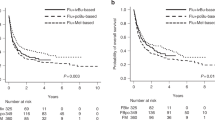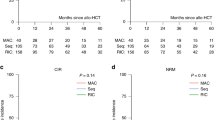Abstract
Allogeneic hematopoietic cell transplantation (HCT) may produce long-term survival in AML after relapse or primary induction failure (PIF). However, outcomes of HCT performed for AML not in remission are historically poor given high relapse rates and transplant-related mortality. Preliminary studies suggest conditioning with clofarabine and myeloablative busulfan (CloBu4) may exert significant anti-leukemic effects without excessive toxicity in refractory hematologic malignancies. A prospective multicenter phase II trial was conducted to determine the efficacy of CloBu4 for patients proceeding directly to HCT with AML not in remission. Seventy-one patients (median age: 56 years) received CloBu4. At day 30 after HCT, 90% achieved morphologic remission. The incidence of non-relapse mortality and relapse at 2 years was 25% and 55%, respectively. The 2-year overall survival (OS) and event-free survival (EFS) were 26% and 20%, respectively. Patients entering HCT in PIF had significantly greater EFS than those in relapse (34% vs 8%; P<0.01). Multivariate analysis comparing CloBu4 with a contemporaneous cohort (Center for International Blood and Marrow Transplantation Research) of AML not in remission receiving other myeloablative conditioning (n=105) demonstrated similar OS (HR: 1.33, 95% confidence interval: 0.92–1.92; P=0.12). HCT with myeloablative CloBu4 is associated with high early response rates and may produce durable remissions in select patients with AML not in remission.
This is a preview of subscription content, access via your institution
Access options
Subscribe to this journal
Receive 12 print issues and online access
$259.00 per year
only $21.58 per issue
Buy this article
- Purchase on Springer Link
- Instant access to full article PDF
Prices may be subject to local taxes which are calculated during checkout



Similar content being viewed by others
References
Fernandez HF, Sun Z, Yao X, Litzow MR, Luger SM, Paietta EM et al. Anthracycline dose intensification in acute myeloid leukemia. N Engl J Med 2009; 361: 1249–1259.
Schiller G, Gajewski J, Nimer S, Territo M, Ho W, Lee M et al. A randomized study of intermediate versus conventional-dose cytarabine as intensive induction for acute myelogenous leukaemia. Br J Haematol 1992; 81: 170–177.
Weick JK, Kopecky KJ, Appelbaum FR, Head DR, Kingsbury LL, Balcerzak SP et al. A randomized investigation of high-dose versus standard-dose cytosine arabinoside with daunorubicin in patients with previously untreated acute myeloid leukemia: a Southwest Oncology Group study. Blood 1996; 88: 2841–2851.
Bishop JF, Matthews JP, Young GA, Bradstock K, Lowenthal RM . Intensified induction chemotherapy with high dose cytarabine and etoposide for acute myeloid leukemia: a review and updated results of the Australian Leukemia Study Group. Leuk Lymphoma 1998; 28: 315–327.
Armistead PM, de Lima M, Pierce S, Qiao W, Wang X, Thall PF et al. Quantifying the survival benefit for allogeneic hematopoietic stem cell transplantation in relapsed acute myelogenous leukemia. Biol Blood Marrow Transplant 2009; 15: 1431–1438.
Breems DA, Van Putten WL, Huijgens PC, Ossenkoppele GJ, Verhoef GE, Verdonck LF et al. Prognostic index for adult patients with acute myeloid leukemia in first relapse. J Clin Oncol 2005; 23: 1969–1978.
Duval M, Klein JP, He W, Cahn JY, Cairo M, Camitta BM et al. Hematopoietic stem-cell transplantation for acute leukemia in relapse or primary induction failure. J Clin Oncol 2010; 28: 3730–3738.
Michallet M, Thomas X, Vernant JP, Kuentz M, Socie G, Esperou-Bourdeau H et al. Long-term outcome after allogeneic hematopoietic stem cell transplantation for advanced stage acute myeloblastic leukemia: a retrospective study of 379 patients reported to the Societe Francaise de Greffe de Moelle (SFGM). Bone Marrow Transplant 2000; 26: 1157–1163.
Biggs JC, Horowitz MM, Gale RP, Ash RC, Atkinson K, Helbig W et al. Bone marrow transplants may cure patients with acute leukemia never achieving remission with chemotherapy. Blood 1992; 80: 1090–1093.
Craddock C, Labopin M, Pillai S, Finke J, Bunjes D, Greinix H et al. Factors predicting outcome after unrelated donor stem cell transplantation in primary refractory acute myeloid leukaemia. Leukemia 2011; 25: 808–813.
Appelbaum FR, Gundacker H, Head DR, Slovak ML, Willman CL, Godwin JE et al. Age and acute myeloid leukemia. Blood 2006; 107: 3481–3485.
Pollyea DA, Kohrt HE, Medeiros BC . Acute myeloid leukaemia in the elderly: a review. Br J Haematol 2011; 152: 524–542.
Magenau JM, Braun T, Reddy P, Parkin B, Pawarode A, Mineishi S et al. Allogeneic transplantation with myeloablative FluBu4 conditioning improves survival compared to reduced intensity FluBu2 conditioning for acute myeloid leukemia in remission. Ann Hematol 2015; 94: 1033–1041.
Shimoni A, Hardan I, Shem-Tov N, Yeshurun M, Yerushalmi R, Avigdor A et al. Allogeneic hematopoietic stem-cell transplantation in AML and MDS using myeloablative versus reduced-intensity conditioning: the role of dose intensity. Leukemia 2006; 20: 322–328.
Aoudjhane M, Labopin M, Gorin NC, Shimoni A, Ruutu T, Kolb HJ et al. Comparative outcome of reduced intensity and myeloablative conditioning regimen in HLA identical sibling allogeneic haematopoietic stem cell transplantation for patients older than 50 years of age with acute myeloblastic leukaemia: a retrospective survey from the Acute Leukemia Working Party (ALWP) of the European group for Blood and Marrow Transplantation (EBMT). Leukemia 2005; 19: 2304–2312.
Ringden O, Labopin M, Ehninger G, Niederwieser D, Olsson R, Basara N et al. Reduced intensity conditioning compared with myeloablative conditioning using unrelated donor transplants in patients with acute myeloid leukemia. J Clin Oncol 2009; 27: 4570–4577.
Song KW, Lipton J . Is it appropriate to offer allogeneic hematopoietic stem cell transplantation to patients with primary refractory acute myeloid leukemia? Bone Marrow Transplant 2005; 36: 183–191.
Faderl S, Ferrajoli A, Wierda W, Huang X, Verstovsek S, Ravandi F et al. Clofarabine combinations as acute myeloid leukemia salvage therapy. Cancer 2008; 113: 2090–2096.
Magenau J, Tobai H, Pawarode A, Braun T, Peres E, Reddy P et al. Clofarabine and busulfan conditioning facilitates engraftment and provides significant antitumor activity in nonremission hematologic malignancies. Blood 2011; 118: 4258–4264.
Andersson BS, Valdez BC, de Lima M, Wang X, Thall PF, Worth LL et al. Clofarabine +/- fludarabine with once daily i.v. busulfan as pretransplant conditioning therapy for advanced myeloid leukemia and MDS. Biol Blood Marrow Transplant 2011; 17: 893–900.
Farag SS, Wood LL, Schwartz JE, Srivastava S, Nelson RP Jr., Robertson MJ et al. Phase I trial and pharmacokinetic study of high-dose clofarabine and busulfan and allogeneic stem cell transplantation in adults with high-risk and refractory acute leukemia. Leukemia 2011; 25: 599–605.
Zebrowski AHA, Mangan J, Pinto-Martin J, Luger S, Loren A, Hexner E et al. Clofarabine busulfan conditioning improves outcomes in patients with active acute myelogenous leukemia undergoing allogeneic stem cell transplant. Blood 2014; 124: 1239 (abstract).
Slovak ML, Kopecky KJ, Cassileth PA, Harrington DH, Theil KS, Mohamed A et al. Karyotypic analysis predicts outcome of preremission and postremission therapy in adult acute myeloid leukemia: a Southwest Oncology Group/Eastern Cooperative Oncology Group Study. Blood 2000; 96: 4075–4083.
Fine JP, Gray RJ . A proportional hazards model for the subdistribution of a competing risk. J Am Stat Assoc 1999; 94: 496–509.
Kantarjian HM, Gandhi V, Kozuch P, Faderl S, Giles F, Cortes J et al. Phase I clinical and pharmacology study of clofarabine in patients with solid and hematologic cancers. J Clin Oncol 2003; 21: 1167–1173.
Srivastava S, Jones D, Wood LL, Schwartz JE, Nelson RP Jr., Abonour R et al. A phase I trial of high-dose clofarabine, etoposide, and cyclophosphamide and autologous peripheral blood stem cell transplantation in patients with primary refractory and relapsed and refractory non-Hodgkin lymphoma. Biol Blood Marrow Transplant 2011; 17: 987–994.
Parkin B, Ouillette P, Yildiz M, Saiya-Cork K, Shedden K, Malek SN . Integrated genomic profiling, therapy response, and survival in adult acute myelogenous leukemia. Clin Cancer Res 2015; 21: 2045–2056.
Grigg AP, Szer J, Beresford J, Dodds A, Bradstock K, Durrant S et al. Factors affecting the outcome of allogeneic bone marrow transplantation for adult patients with refractory or relapsed acute leukaemia. Br J Haematol 1999; 107: 409–418.
Wong R, Shahjahan M, Wang X, Thall PF, De Lima M, Khouri I et al. Prognostic factors for outcomes of patients with refractory or relapsed acute myelogenous leukemia or myelodysplastic syndromes undergoing allogeneic progenitor cell transplantation. Biol Blood Marrow Transplant 2005; 11: 108–114.
Copelan EA, Hamilton BK, Avalos B, Ahn KW, Bolwell BJ, Zhu X et al. Better leukemia-free and overall survival in AML in first remission following cyclophosphamide in combination with busulfan compared with TBI. Blood 2013; 122: 3863–3870.
Farag SS, Bolwell BJ, Elder PJ, Kalaycio M, Lin T, Pohlman B et al. High-dose busulfan, cyclophosphamide, and etoposide does not improve outcome of allogeneic stem cell transplantation compared to BuCy2 in patients with acute myeloid leukemia. Bone Marrow Transplant 2005; 35: 653–661.
Chen YB, Li S, Lane AA, Connolly C, Del Rio C, Valles B et al. Phase I trial of maintenance sorafenib after allogeneic hematopoietic stem cell transplantation for fms-like tyrosine kinase 3 internal tandem duplication acute myeloid leukemia. Biol Blood Marrow Transplant 2014; 20: 2042–2048.
de Lima M, Giralt S, Thall PF, de Padua Silva L, Jones RB, Komanduri K et al. Maintenance therapy with low-dose azacitidine after allogeneic hematopoietic stem cell transplantation for recurrent acute myelogenous leukemia or myelodysplastic syndrome: a dose and schedule finding study. Cancer 2010; 116: 5420–5431.
Schroeder T, Czibere A, Platzbecker U, Bug G, Uharek L, Luft T et al. Azacitidine and donor lymphocyte infusions as first salvage therapy for relapse of AML or MDS after allogeneic stem cell transplantation. Leukemia 2013; 27: 1229–1235.
Toubai T, Sun Y, Luker G, Liu J, Luker KE, Tawara I et al. Host-derived CD8+ dendritic cells are required for induction of optimal graft-versus-tumor responses after experimental allogeneic bone marrow transplantation. Blood 2013; 121: 4231–4241.
Acknowledgements
We wish to acknowledge Otsuka Pharmaceutical Co., Ltd. and Sanofi-Aventis U.S. LLC for providing research support to cover the costs of conducting this clinical trial. Sanofi-Aventis also provided clofarabine at no charge.
Author information
Authors and Affiliations
Corresponding author
Ethics declarations
Competing interests
HP has received honoraria and has served in as a consultant for Sanofi. The remaining authors declare no conflict of interest. This was an investigator initiated trial with Research Support provided by Otsuka Pharmaceutical Co., Ltd. and Sanofi-Aventis U.S. LLC. The authors are solely responsible for the design, data collection, analysis and decision to publish this trial.
Rights and permissions
About this article
Cite this article
Magenau, J., Westervelt, P., Khaled, S. et al. A multicenter trial of myeloablative clofarabine and busulfan conditioning for relapsed or primary induction failure AML not in remission at the time of allogeneic hematopoietic stem cell transplantation. Bone Marrow Transplant 52, 59–65 (2017). https://doi.org/10.1038/bmt.2016.188
Received:
Revised:
Accepted:
Published:
Issue Date:
DOI: https://doi.org/10.1038/bmt.2016.188
This article is cited by
-
Pretransplantation predictors of survival in nonremission acute myeloid leukemia treated with haploidentical transplantation using steroid-based GVHD prophylaxis
Annals of Hematology (2024)
-
Re-induction therapy in patients with acute myeloid leukemia not in complete remission after the first course of treatment
Annals of Hematology (2023)
-
Myeloablative intravenous busulfan-containing regimens for allo-HSCT in AML or MDS patients over 54 years old: combined results of three phase II studies
International Journal of Hematology (2020)
-
The safety and efficacy of clofarabine in combination with high-dose cytarabine and total body irradiation myeloablative conditioning and allogeneic stem cell transplantation in children, adolescents, and young adults (CAYA) with poor-risk acute leukemia
Bone Marrow Transplantation (2019)
-
Clofarabine followed by haploidentical stem cell transplant using fludarabine, busulfan, and total-body irradiation with post-transplant cyclophosphamide in non-remission AML
International Journal of Hematology (2018)



